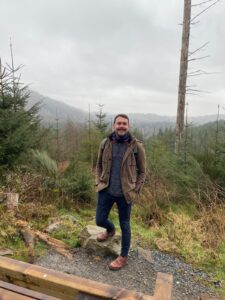Matthew Wadge
What is your current job?
Third Century Fellow in Surface Engineering, Manchester Metropolitan University 
What A-Levels (or equivalent) did you do?
Maths, Physics and Chemsity plus Further Math AS level
Why did you chose a career in Materials Science and Engineering (MSE)?
For me it was by accident! I initially applied to do Medicine at University, and after 9 rejections it was clear I wasn’t cut out for Medicine… My backup choice was Biomedical Materials Science at Nottingham University, and from there I was hooked! I have since completed a PhD in Materials Engineering and Materials Design and had been a Research Fellow for 4 years at Nottingham before moving to ManMet in Nov. 2024.
What did you enjoy most about your MSE course? (If you didn’t do a MSE course which course did you do and what led to you MSE?)
Personally, I found my research project in my final year the most enjoyable part! I studied Biomedical Materials Science, which is essentially understanding materials, their properties and ultimately how these properties affect your cells and tissue once they are implanted/used in a medical context. My supervisors, Prof David Grant, was very supportive of my ideas, and ultimately my project was something I had come up with and wanted to explore – having that freedom is the reason I am in a research role now!
What is your research about?
My research looks at modifying surfaces, through a variety of different methods, to improve their structure, topography, chemical, as well as biological properties. I mainly work with a class of materials called “Titanates”, and I focus on making these materials porous, to allow bone cells to interlock and bond with the surface, bioactive, to allow bone to grow and mature, as well as antibacterial, to ward off infections at the implantation site.
What is the coolest thing you have done in your career so far?
My coolest achievement was a “Friday afternoon” experiment I did at the end of my PhD. I was working on these “hairy” titanate structures and following a conversation with one of my supervisors, Prof. Ifty Ahmed, we decided to try and apply these surfaces to metallic microspheres. It turns out, when you add these surfaces to metal microspheres in the right way, you can get them to self-assemble into 3D porous scaffolds!
What do you see yourself doing in the future?
I hope to still be researching, as well as teaching the next generation of Material Scientists!
What is your favourite material (and why)?
I have to say sodium titanate! I spent my PhD working on this material, and developing new ways of utilising this material, and its diverse properties: porous, can facilitate bone to grow, can be antibacterial, easy and cheap to generate, the list goes on! Equally, it looks very cool under an electron microscope!
What advice would you give your 16 year old self?
To work hard (I became complacent when I transitioned from GCSEs to A Levels…) and not to worry about getting things wrong (I have become a perfectionist, and it can be quite difficult dealing with things that don’t go to plan!)
Links
ManMet Website: Dr Matthew Wadge | Manchester Metropolitan University
LinkedIn: (6) Matthew Wadge | LinkedIn

